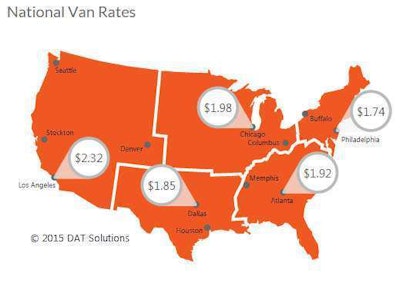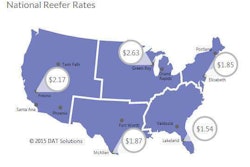For Overdrive’s rate spotlight for this week, the DAT network of load boards reports outbound dry van demand on the spot market cooled off markedly in the Pacific Northwest states as well as Florida and elsewhere for a national van load-to-truck ratio that fell from 2.0 to 1.7. California and Arizona remain in the “hot states” column, showing local/regional ratios well above average, while Texas fell off the map.
 Arkansas and Mississippi remained hot as well. In the chart, the darker the shaded color, the higher the load to truck ratio, indicating a stronger carrier negotiating position.
Arkansas and Mississippi remained hot as well. In the chart, the darker the shaded color, the higher the load to truck ratio, indicating a stronger carrier negotiating position.Meanwhile, rates fell off a little in most major markets, DAT says.
 The national average rate lost 2 cents per mile. Stockton, Calif., rates bucked the trend with a 2-cent boost per mile. Consumer confidence is reportedly improving in July, however, sending a hopeful signal that could lead to higher freight volume in the fall.
The national average rate lost 2 cents per mile. Stockton, Calif., rates bucked the trend with a 2-cent boost per mile. Consumer confidence is reportedly improving in July, however, sending a hopeful signal that could lead to higher freight volume in the fall.The Stockton-to-Seattle run — averaging nearly $3 a mile for van owner-operators last week — heads up this week’s load-planning strategy highlight.
 The return trip showed a $1.18-per-mile average from Seattle back to Stockton, for a round-trip of $2.07 per mile, or $3,308 for all loaded miles. Improving on that can be done, DAT data suggests, by splitting the long north-south run into two shorter hauls — Seattle to Medford, Ore., take your 10, grab another load and head on down I-5 to Stockton. Based on last week’s average rates, you can add $498 to your roundtrip revenue, at an average rate of $2.38 per loaded mile. So-called “TriHaul” route suggestions are offered in DAT Express and DAT Power load boards, the company notes.
The return trip showed a $1.18-per-mile average from Seattle back to Stockton, for a round-trip of $2.07 per mile, or $3,308 for all loaded miles. Improving on that can be done, DAT data suggests, by splitting the long north-south run into two shorter hauls — Seattle to Medford, Ore., take your 10, grab another load and head on down I-5 to Stockton. Based on last week’s average rates, you can add $498 to your roundtrip revenue, at an average rate of $2.38 per loaded mile. So-called “TriHaul” route suggestions are offered in DAT Express and DAT Power load boards, the company notes.All spot market rate averages highlighted for the week are derived from DAT RateView, and are based on rate agreements between freight brokers and carriers. Reference rates include fuel surcharges but not accessorial or other fees.









